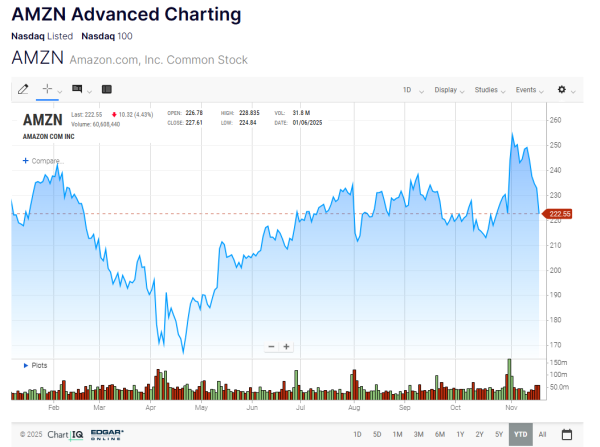Amazon (AMZN) has long been considered one of the most dominant and transformative companies in the world. Over the last decade, the company’s relentless customer-centric strategy has helped fuel an extraordinary 613% share price increase, propelling its market value to roughly $2.5 trillion as of November 2024.
With $691 billion in trailing-12-month revenue and a sprawling footprint that includes e-commerce, digital advertising, cloud computing, and artificial intelligence (AI), Amazon remains a cornerstone in countless portfolios.
Yet amid the company’s massive scale, global reach, and steady flow of headline-grabbing innovations, brokers at Logirium emphasize that there is one financial metric every Amazon investor must monitor closely, a measure that cuts through accounting noise to reveal the company’s true underlying profitability. That metric is free cash flow (FCF).
Free Cash Flow: Amazon’s Most Important Indicator
Free cash flow (FCF) represents the cash Amazon has left after covering operating expenses and capital expenditures. Unlike net income, which can be influenced by accounting adjustments, FCF reveals Amazon’s true cash-generating power.
This surplus cash is essential because it enables reinvestment, debt reduction, share buybacks, and overall strengthening of the company’s financial position. And the trend in recent years has been dramatic.
From negative free cash flow in 2021 and 2022, Amazon staged a substantial turnaround, producing:
- $36.8 billion in FCF for 2023
- $38.2 billion in FCF for 2024
This shift signaled not only improved profitability but also strong operating leverage across Amazon Web Services (AWS), advertising, and core retail operations as supply chain expenses eased following the pandemic-era surge.
For a company of Amazon’s scale, such a rebound underscores the health of the business and validates its massive investments in fulfillment centers, AI infrastructure, and cloud computing.
But now, investors face a new question: Can Amazon maintain or expand free cash flow as it pours unprecedented sums into AI?

AI: Amazon’s Largest Cash Commitment Yet
Amazon isn’t simply dabbling in artificial intelligence; it is committing to it on a scale matched only by the likes of Microsoft and Alphabet.
In 2024 alone, Amazon plans to spend $125 billion in capital expenditures, a significant portion of which is tied to generative AI infrastructure, model training, inference capabilities, and investments in energy-hungry data centers.
These initiatives include:
- Scaling AWS infrastructure to support advanced AI workloads
- Integrating AI models into consumer products like Alexa and Amazon Logistics
- Expanding partnerships with AI start-ups
- Increasing semiconductor development through Amazon-designed chips like Trainium and Inferentia
While these investments position Amazon to remain competitive in one of the most important technological races of the century, they come at a cost. And unlike previous infrastructure spending cycles, the scale is unprecedented.
This is why FCF matters more than ever: it will show whether Amazon’s AI spending is generating meaningful returns.
Analysts Expect a Sharp Dip in Free Cash Flow
Wall Street analysts currently project that Amazon’s free cash flow will fall by 45% year-over-year in 2025, reflecting the massive CapEx planned.
For many companies, such a decline would raise red flags. However, Amazon has a history of making enormous long-term investments, many of which paid off handsomely:
- The creation of AWS
- The nationwide fulfillment network
- Amazon Prime
- The advertising ecosystem
AI may ultimately fit the same pattern. But in the interim, the pressure on free cash flow will be intense.
Investors, therefore, must watch closely to determine:
- How quickly AI investments begin contributing to revenue
- Whether AWS growth accelerates as AI adoption scales
- If margin improvements in retail and advertising offset AI-related CapEx
- How efficiently Amazon manages its infrastructure expansion
If FCF rebounds sooner than expected, it would strongly signal that Amazon’s AI strategy is working and could support continued share price appreciation.

Why This Metric Matters for Long-Term Shareholders
Free cash flow (FCF) is the key metric that consolidates Amazon’s various performance indicators, showing true profitability, effectiveness of capital allocation, flexibility to return value to shareholders, and whether growth initiatives like AI are paying off. With Amazon’s heavy spending and AI bets, FCF trends are crucial for assessing financial strength and future valuation.
Final Takeaway
Amazon remains one of the world’s most dominant, innovative, and resilient enterprises. Its rapid recovery in free cash flow during 2023 and 2024 showed a company capable of navigating inflation, supply chain pressures, and rising infrastructure costs.
But with Amazon preparing for its most aggressive investment cycle in history, free cash flow will determine whether the next decade mirrors the past decade’s spectacular growth.
For investors, especially those following insights from analysts, this metric should remain front and center.







